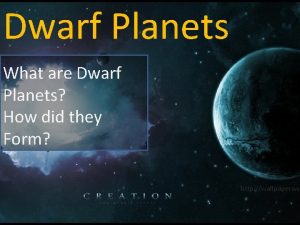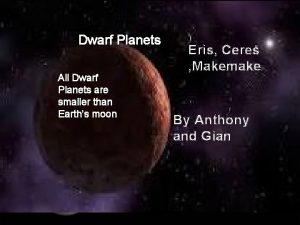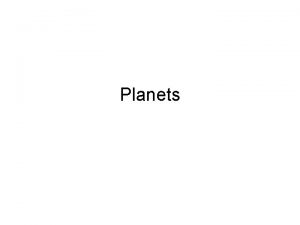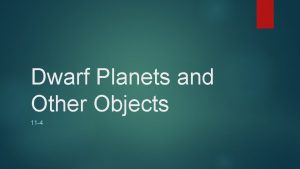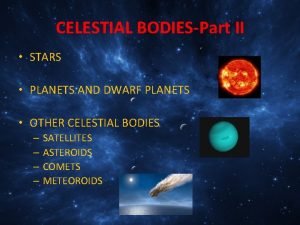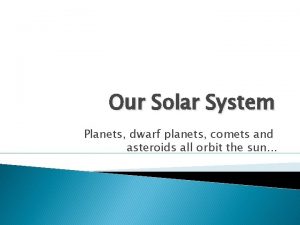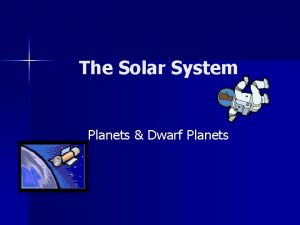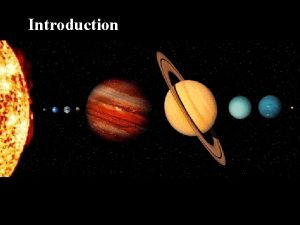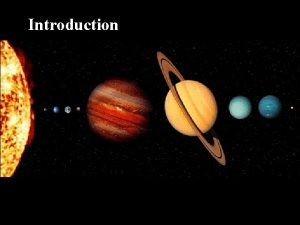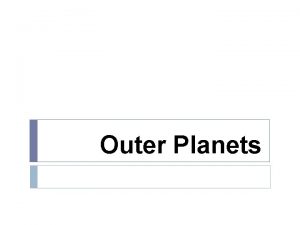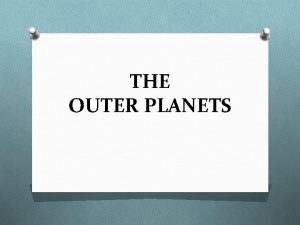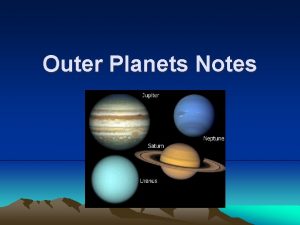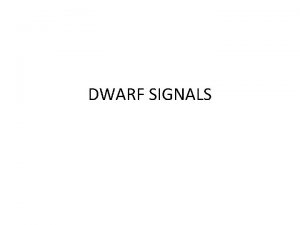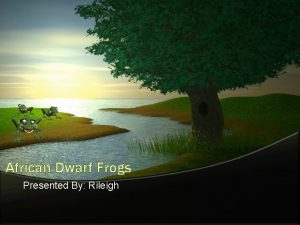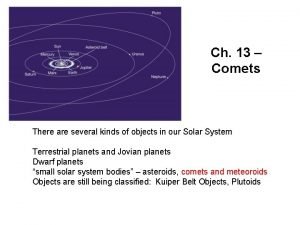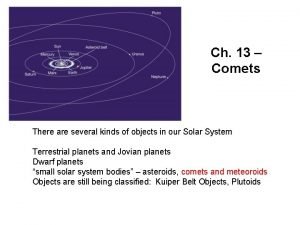Ch 12 Dwarf Planets There are several kinds

























- Slides: 25

Ch. 12 Dwarf Planets There are several kinds of objects in our Solar System Terrestrial planets and Jovian planets, with satellites (moons) Dwarf planets (which can also have moons) and “small solar system bodies” – asteroids, comets and meteoroids Objects are still being classified: Kuiper Belt Objects, Plutoids, Plutinos, Trans-Neptunian Objects (TNOs), Oort cloud objects

From largest to smallest, the objects in the Solar System can be classified into categories Notice that there is some overlap among objects of the same size.

Best available picture of Pluto, prior to 2015, taken with the Hubble telescope in orbit

Pluto can barely be resolved by telescopes from Earth. This image of Pluto is from the Hubble telescope.

Small objects are discovered by comparing photos taken at different times or days. Pluto was discovered by this method in 1930.

The period of Pluto’s orbit is 248 years.

The orbit of Pluto is tilted and elliptical (e = 0. 25)

A moon of Pluto was discovered by noticing a bulge in some photos of Pluto.

Pluto and its moon Charon are almost like a double planet. Better photos show two smaller moons: Nix and Hydra.

Better photos show two smaller moons: Nix and Hydra.

The New Horizons spacecraft flew by Pluto in July 2015 and greatly increased our knowledge of this dwarf planet. Websites: http: //pluto. jhuapl. edu/ http: //www. nasa. gov/mission_pages/newhorizons/main/index. html

http: //pluto. jhuapl. edu/Mission/Where-is-New-Horizons/index. php






• Pluto images, best seen in a web browser: • • Methane snow on peaks http: //pluto. jhuapl. edu/Galleries/Featured-Images/image. php? page=1&gallery_id=2&image_id=231 • • High resolution pictures of Sputnik Planum, an ocean of solid nitrogen http: //pluto. jhuapl. edu/Galleries/Featured-Images/image. php? page=8&gallery_id=2&image_id=240 http: //pluto. jhuapl. edu/Galleries/Featured-Images/image. php? page=10&gallery_id=2&image_id=277 http: //pluto. jhuapl. edu/Galleries/Featured-Images/image. php? page=13&gallery_id=2&image_id=387 • • • Mountains and plains, with haze layers http: //pluto. jhuapl. edu/Galleries/Featured-Images/image. php? page=11&gallery_id=2&image_id=300 http: //pluto. jhuapl. edu/Galleries/Featured-Images/image. php? page=11&gallery_id=2&image_id=282 • • geology map with color to denote different types of surface http: //pluto. jhuapl. edu/Galleries/Featured-Images/image. php? page=15&gallery_id=2&image_id=409 • • New Horizons trajectory http: //pluto. jhuapl. edu/Mission/Where-is-New-Horizons/index. php • For class, we downloaded 3 videos and saved them to the classroom PC.

The Pluto–Charon Orbit is so unusual that it probably means Charon is captured, and not co-evolved with Pluto

Kuiper Belt Objects Compared to Moon and Earth. Notice that we think Triton was captured by Neptune, and is really an object like Pluto and the KBOs. However, the New Horizons results show that Triton and Pluto are quite different. Also see this web page about KBOs: http: //www 2. ess. ucla. edu/~jewitt/kb. html

Ultima Thule – a Kuiper Belt Object past Pluto • The Kuiper Belt is a “third zone” of the Solar system: • http: //pluto. jhuapl. edu/Galleries/Featured-Images/image. php? page=23&gallery_id=2&image_id=561 • After the Pluto flyby, New Horizons was directed toward a small KBO initially called 2014 MU 69; the trajectory is shown at • http: //pluto. jhuapl. edu/Mission/Where-is-New-Horizons. php#Current-Position • Now called Ultima Thule, this KBO has a completely unexpected shape, like a snowman: • http: //pluto. jhuapl. edu/Galleries/Featured-Images/image. php? page=25&gallery_id=2&image_id=596

Eris is a dwarf planet even further than Pluto.

Keck telescope image of Eris and its moon Dysnomia.

Dwarf Planets – five known so far • Dwarf planets are round due to gravity, but not big enough to clear out the other objects in their orbit. • In 2006 three objects—Pluto, Ceres, and Eris—were classified as dwarf planets. Later, we observed Haumea and Makemake, so there are 5 dwarf planets. • Ceres is in the asteroid belt; the other dwarf planets are in the Kuiper Belt out past Neptune. • Many other objects orbit the Sun beyond Neptune. For example, at least 1277 KBO’s have been observed. A few potential Oort cloud objects have also been identified. New classification schemes are being proposed. • Lists are at https: //en. wikipedia. org/wiki/Dwarf_planet

The orbit of Sedna is huge compared to even the Kuiper belt, and may extend to the Oort cloud. This object has not yet been classified.
 Insidan region jh
Insidan region jh The inner solar system by leslie
The inner solar system by leslie Inner terrestrial planets
Inner terrestrial planets 9 planets
9 planets Are jovian planets more dense than terrestrial
Are jovian planets more dense than terrestrial Solar system jeopardy
Solar system jeopardy There are several ways
There are several ways There are three kinds of lies
There are three kinds of lies How many kinds of letter are there
How many kinds of letter are there There are many different kinds of sports
There are many different kinds of sports Stanza poem
Stanza poem How many types of energy are there
How many types of energy are there Altruistic love
Altruistic love 適配度指標
適配度指標 How many kinds of energy are there
How many kinds of energy are there Different types of sports
Different types of sports Kinds of sports
Kinds of sports There are four kinds of sentence
There are four kinds of sentence Types of sentences
Types of sentences Black dwarf star
Black dwarf star Pluto planta
Pluto planta Star objective
Star objective Pluto planta
Pluto planta Brown dwarf
Brown dwarf The dwarf cho se hui
The dwarf cho se hui Dwarf thread worm
Dwarf thread worm


























